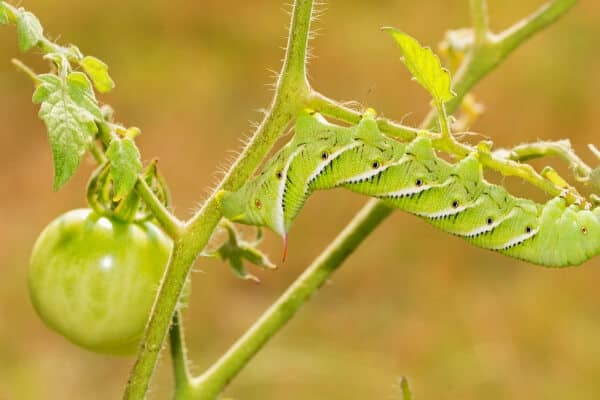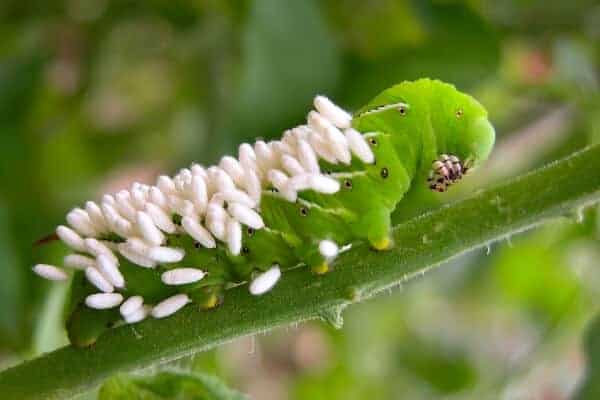Are caterpillars eating all your tomatoes? Learn how to get rid of tomato hornworms in your vegetable garden naturally!
If you have been growing tomatoes for very long at all, I am sure you have come across the occasional tomato hornworm- or evidence that one has been through your garden.
This site contains affiliate links. If you make a purchase using one of these links, I may earn a commission. Please see my disclosure page for more information about cookies collected and our privacy policy.
These large green caterpillars are actually the larva of sphinx moths or hawkmoths, but it’s the caterpillar stage that is most destructive for home gardeners.
There are actually 2 kinds of hornworms that can be found in the vegetable garden- the tomato hornworm and the tobacco hornworm. Both are very similar and have similar diets. These caterpillars feed on tomatoes, peppers, eggplant, and other members of the nightshade (Solanaceae) family.
Identification is easy- they are bright green with white lines striping their sides and black dots down their sides. They also have a thorn-like horn protruding from their back.
They can reach up to 5 inches long and you usually don’t notice them until they are almost full size!
So if you have found evidence that hornworms are eating your crops- what can you do to get rid of them? Here are 6 different, totally natural ways to get rid of these caterpillars in your organic garden.
6 Ways to Get Rid of Tomato Hornworms in Your Vegetable Garden- Naturally!
Since their diets are nearly identical, you will likely deal with both tobacco and tomato hornworms, these methods will work for getting rid of either species.
Remove Tomato Hornworms by Hand
Tomato hornworms may be gross and the thought of picking them off may make you squirm, but it really it the #1 method of defense when it come to getting rid of them naturally.
Despite their size, tomato hornworms can actually camouflage quite well and you often have trouble finding them even when they are huge.
In my garden I find them by looking at the ground first. I crawl along the rows looking for signs of caterpillar poop. I’m usually already down their, staking, pinching suckers, or checking ripeness, so it’s just one more thing on my list.
If you come across caterpillar droppings, stop and loop up into the plant and look for signs that a hornworm is there, such as missing leaves. Like I said, they can hide well, but eventually you will find them.
Drop them into a jug of soapy water or collect them in a bucket for your chickens!
It may seem time intensive but hand picking should be a daily job in the garden. I do it for all sorts of bugs like squash bugs and potato beetles– so adding in the hornworms isn’t much different.
Use Companion Planting
Companion planting is one of my favorite ways to control pests in the garden. And it can be a great help when controlling tomato hornworms.
The most common plants that help with hornworms are:
- Borage
- Calendula
- Marigold (Tagetes)
These herbs and flowers can both deter the worms or confuse the sense of smell.
Plant them throughout your garden rows. I plant a calendula or 2 in almost every tomato row!
Related: The Best Companion Plants for Tomatoes
Plant a Trap Crop
Trap crops work by planting a more desirable crop to draw pests to that sacrificial plant instead.
The most beneficial trap crop for luring hornworms is the moonflower.
Remember, trap crops work by luring the pest to THEM instead of the tomatoes, then you can destroy them from there.
Learn more about trap crops: How to Use Trap Crops to Control Pests in the Garden
Attract Beneficial Insects
Beneficial insects are like your soldiers in the war against pests. They can help make the difference between losing a crop to a pest and winning.
Luckily there are quite a few beneficial insects that can help you control tomato hornworms. Such as:
- Braconid Wasp
- Green Lacewing
- Ladybug
Most of these predatory insects work by either destroying/feeding on the hornworm or it’s eggs.
The braconid wasp is the most helpful as it’s parasitic wasp that lays their eggs on the hornworm, the larva hatches and feeds on the pest. So if you ever see a caterpillar covered in rows of white eggs- don’t pick it off! Let the eggs hatch and do their job and you will have even more beneficial insects to help you.
Read more about beneficials and how to attract them.
Tilling the Soil
Tomato hornworms overwinter in the soil of your garden, so tilling in the fall can help dig up and destroy these pupae.
If you are growing a no-till garden there are some alternatives to this that can work well. One alternative is allowing chickens in the garden during the off season. They will scratch, peck, and eat lots of the overwintering bugs in your garden beds! This also goes for all the other poultry- ducks and guineas especially.
Luckily, hornworms don’t usually get out of control, but if you seem to have an infestation and don’t already till, you might give it a try.
Organic Insecticides
I personally don’t like to spray much of anything on my garden- organic or not. But sometimes it’s a must.
Here are some organic options when it comes to spraying or treating your plants to control hornworms.
- Bacillus Thuringiensis is a bacterial based insecticide. It’s helpful for all sorts of garden pests including hornworms. I like it because it doesn’t affect bees or ladybugs.
- Diatomaceous Earth . While I used DE for controlling flea beetles, I don’t usually use it for hornworms. This is because hornworms tend to be a bigger problem in the mid to late season and I don’t want to risk getting DE near the bees and other pollinators. But it is an option if you choose to take it.
More Organic Gardening Articles
The Best Essential Oils for the Garden
How to Use Companion Planting to Control Aphids
7 Ways to Get Rid of Spider Mites Naturally







Are some of those worms monarch butterflies which could go extinct? They are beautiful and they love milk weeds. If I planted 1 or two milkweed in my garden, wouldn’t that keep them out of the garden? I wouldn’t want to see these go extinct.
Monarch and hornworms are totally different. Monarch’s won’t bother your garden.